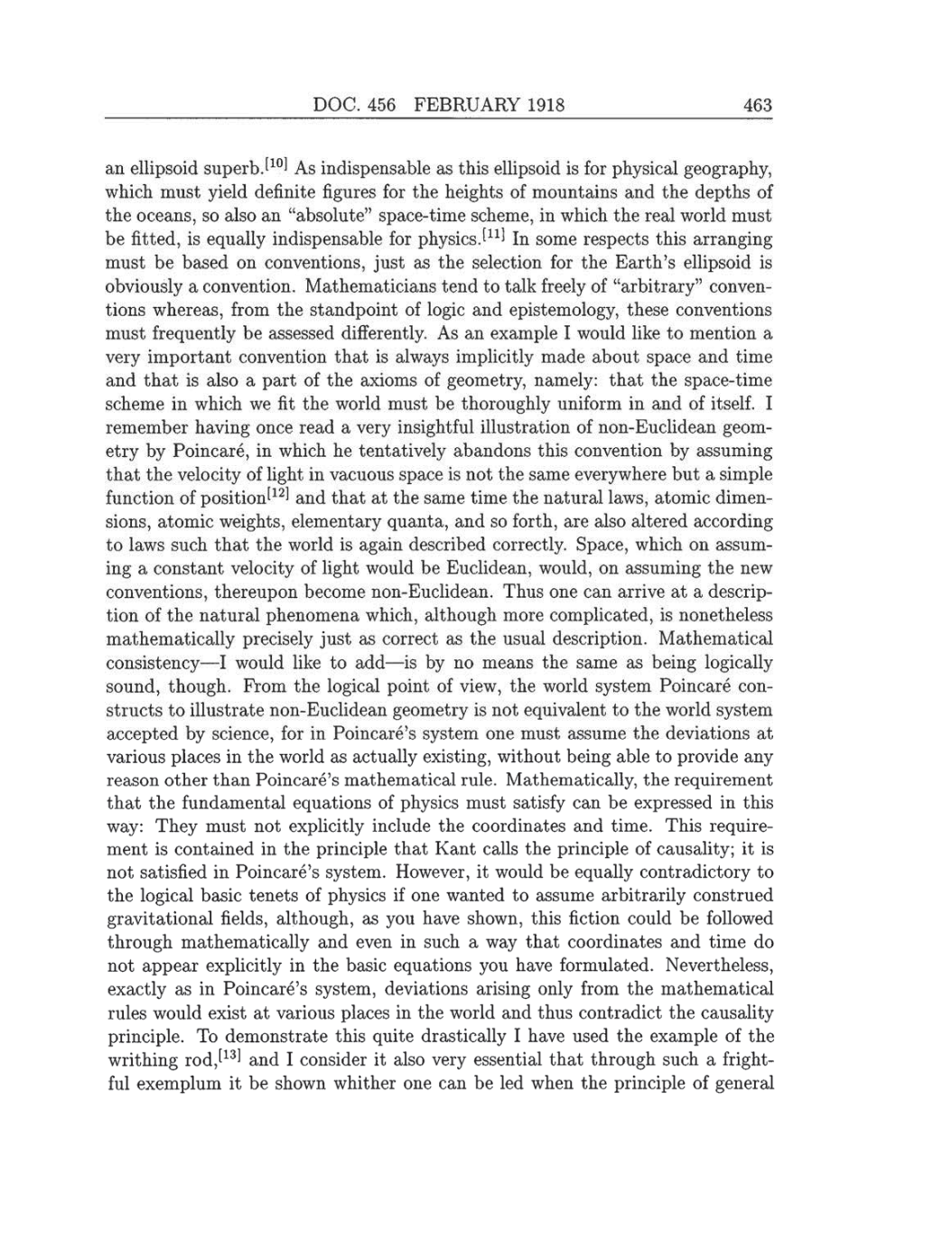DOC.
456
FEBRUARY
1918 463
an
ellipsoid
superb.[10]
As
indispensable
as
this
ellipsoid
is
for
physical geography,
which
must
yield
definite
figures
for
the
heights
of mountains and
the
depths
of
the
oceans,
so
also
an
“absolute”
space-time scheme,
in which
the
real world must
be
fitted,
is
equally indispensable
for
physics.[11]
In
some
respects
this
arranging
must be based
on
conventions,
just
as
the
selection for
the Earth’s
ellipsoid
is
obviously
a
convention. Mathematicians
tend
to
talk
freely
of
“arbitrary”
conven-
tions
whereas,
from
the
standpoint of
logic
and
epistemology,
these conventions
must
frequently
be assessed
differently.
As
an
example
I
would
like to
mention
a
very
important
convention
that
is
always implicitly
made
about
space
and
time
and
that
is
also
a
part
of
the
axioms of
geometry, namely:
that the
space-time
scheme in which
we
fit
the
world must be
thoroughly
uniform in and
of
itself.
I
remember
having
once
read
a
very insightful
illustration
of non-Euclidean
geom-
etry
by
Poincaré,
in which he
tentatively
abandons this convention
by assuming
that the
velocity
of
light
in
vacuous
space
is
not
the
same
everywhere
but
a
simple
function of
position[12]
and
that
at
the
same
time
the natural
laws,
atomic dimen-
sions,
atomic
weights, elementary
quanta,
and
so
forth,
are
also
altered
according
to
laws such
that the
world
is
again
described
correctly. Space,
which
on assum-
ing
a
constant
velocity
of
light
would be
Euclidean, would,
on
assuming
the
new
conventions,
thereupon
become non-Euclidean. Thus
one can
arrive
at
a
descrip-
tion
of
the natural
phenomena which, although
more
complicated,
is
nonetheless
mathematically
precisely
just
as
correct
as
the
usual
description.
Mathematical
consistency-I
would
like
to
add-is
by no means
the
same as being logically
sound,
though.
From
the
logical
point
of
view,
the world
system
Poincaré
con-
structs to
illustrate
non-Euclidean
geometry
is
not
equivalent
to
the
world
system
accepted by science,
for in Poincaré’s
system
one
must
assume
the
deviations
at
various
places
in
the
world
as
actually existing,
without
being
able to
provide any
reason
other than Poincare’s mathematical rule.
Mathematically,
the
requirement
that the fundamental
equations
of
physics
must
satisfy
can
be
expressed
in
this
way:
They
must not
explicitly
include
the
coordinates and time. This
require-
ment is
contained in
the
principle
that Kant
calls
the
principle
of
causality;
it
is
not
satisfied in Poincare’s
system.
However,
it would be
equally
contradictory to
the
logical
basic
tenets of
physics
if
one
wanted to
assume
arbitrarily
construed
gravitational
fields, although, as you
have
shown,
this fiction could be followed
through mathematically
and
even
in such
a way
that
coordinates
and time
do
not
appear explicitly
in
the
basic
equations you
have formulated.
Nevertheless,
exactly
as
in Poincare’s
system,
deviations
arising only
from
the mathematical
rules would exist
at
various
places
in the world
and
thus contradict the
causality
principle.
To
demonstrate
this
quite drastically
I
have used
the
example
of
the
writhing
rod,[13]
and
I
consider it also
very
essential
that
through
such
a
fright-
ful
exemplum
it be shown whither
one can
be led when
the
principle
of
general
